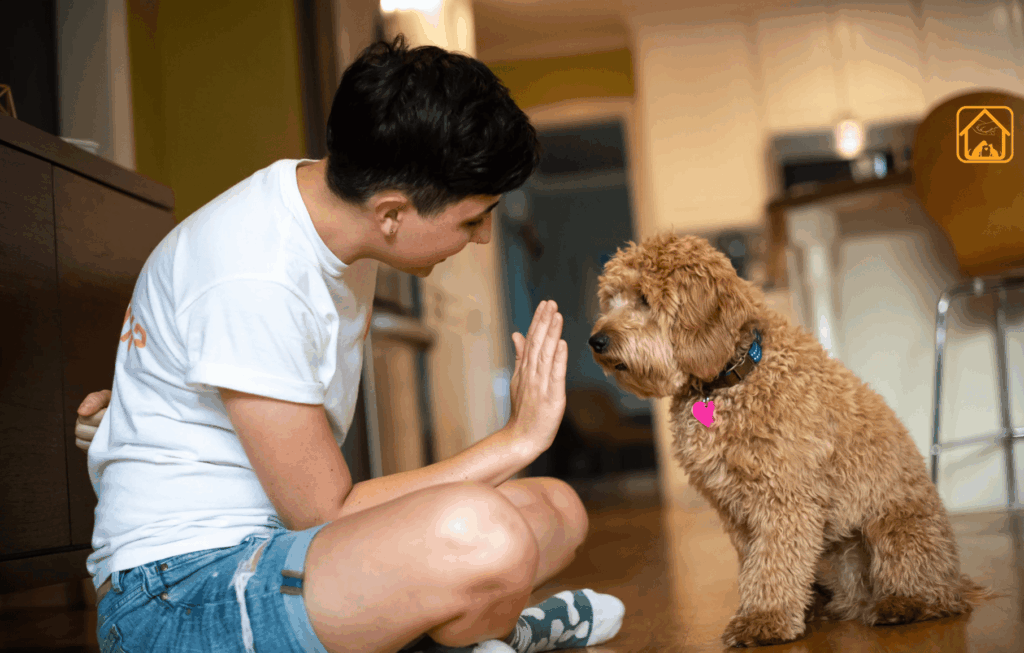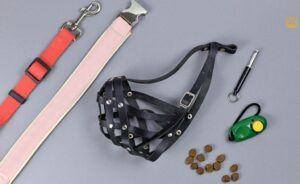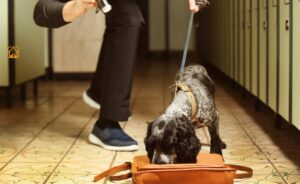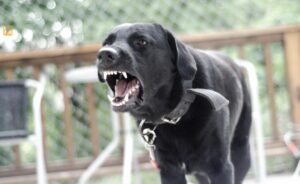When to Start Puppy Training and Why It Matters
Puppy training should begin the moment your puppy steps paw in your home, typically around 8 weeks old. At this age, puppies are eager to learn and soak up new experiences, from recognizing their name to picking up basic commands. Early training shapes lifelong behavior and creates a strong bond between you and your pup.
- It shapes their future. Early puppy training lays down the rules for what’s safe, acceptable, and fun. A pup who learns gentle play at twelve weeks is far less likely to develop nipping or jumping problems later.
- Reduces stress for everyone. House puppies who understand boundaries like where to pee and what not to chew mean less frustration, fewer messes, and more joy at home.
- Strengthens your bond. Positive, reward-based training teaches your puppy to trust and look to you for guidance. That trust makes every future challenge, like vet visits, traveling, or meeting new people, so much easier.
- Prevents behavior issues. Most problem behaviors (barking, separation anxiety, destructive chewing) are easier to prevent than fix. Early canine obedience training gives your puppy the mental exercise and structure they crave.
There’s a sweet spot for learning, puppies between 6 and 16 weeks are especially open to socialization and new skills. Waiting too long can make some habits harder to change. Think of it like teaching a child, early, gentle guidance just sticks better. And don’t stress if your puppy is a little older! It’s never too late to start, but the earlier you begin, the smoother the process will be.
Creating a Puppy Training Schedule by Age
0-8 Weeks: Settling In
- Focus on gentle handling and getting used to basic routines.
- Start name recognition and positive associations with you.
8-10 Weeks: Foundations
- Introduce short puppy training sessions, 2-5 minutes, a few times daily.
- Begin potty training, crate training, and simple commands like “sit” and “come.”
- Reward positive behavior with treats, praise, or toys.
10-16 Weeks: Building Skills
- Work on leash training and introduce “stay,” “down,” and “leave it.”
- Socialize with new people, sounds, and gentle dogs (after vaccines).
- Stick to a consistent routine: meals, potty breaks, play, and naps.
4-6 Months: Practice and Consistency
- Reinforce all learned commands, add distractions and longer durations.
- Practice in new environments: parks, sidewalks, or dog-friendly stores.
6 Months and Up: Advanced Training and Reinforcement
- Try advanced tricks, longer stays, and more complex socialization.
- Keep up daily sessions, but make them fun and varied to keep your puppy engaged.
Quick table for your reference:
| Age Range | Training Focus |
| 0–8 Weeks | – Gentle handling and bonding- Getting used to home routines- Start name recognition and positive reinforcement |
| 8–10 Weeks | – Short training sessions (2–5 min, a few times daily)- Begin potty and crate training- Teach simple commands like “sit” and “come”- Reward with treats, praise, or toys |
| 10–16 Weeks | – Leash training- Introduce “stay,” “down,” and “leave it”- Socialize with people, sounds, and safe dogs- Establish a daily routine |
| 4–6 Months | – Reinforce earlier commands- Add distractions and longer training duration- Practice in varied environments (parks, sidewalks, stores) |
| 6 Months and Up | – Introduce advanced tricks and commands- Work on longer “stays” and impulse control- Keep sessions fun, short, and consistent |
Every pup learns at their own pace. My own dog took ages to master “leave it”, but with a steady schedule, he got there.
Crate Training a Puppy: Step-by-Step Guide
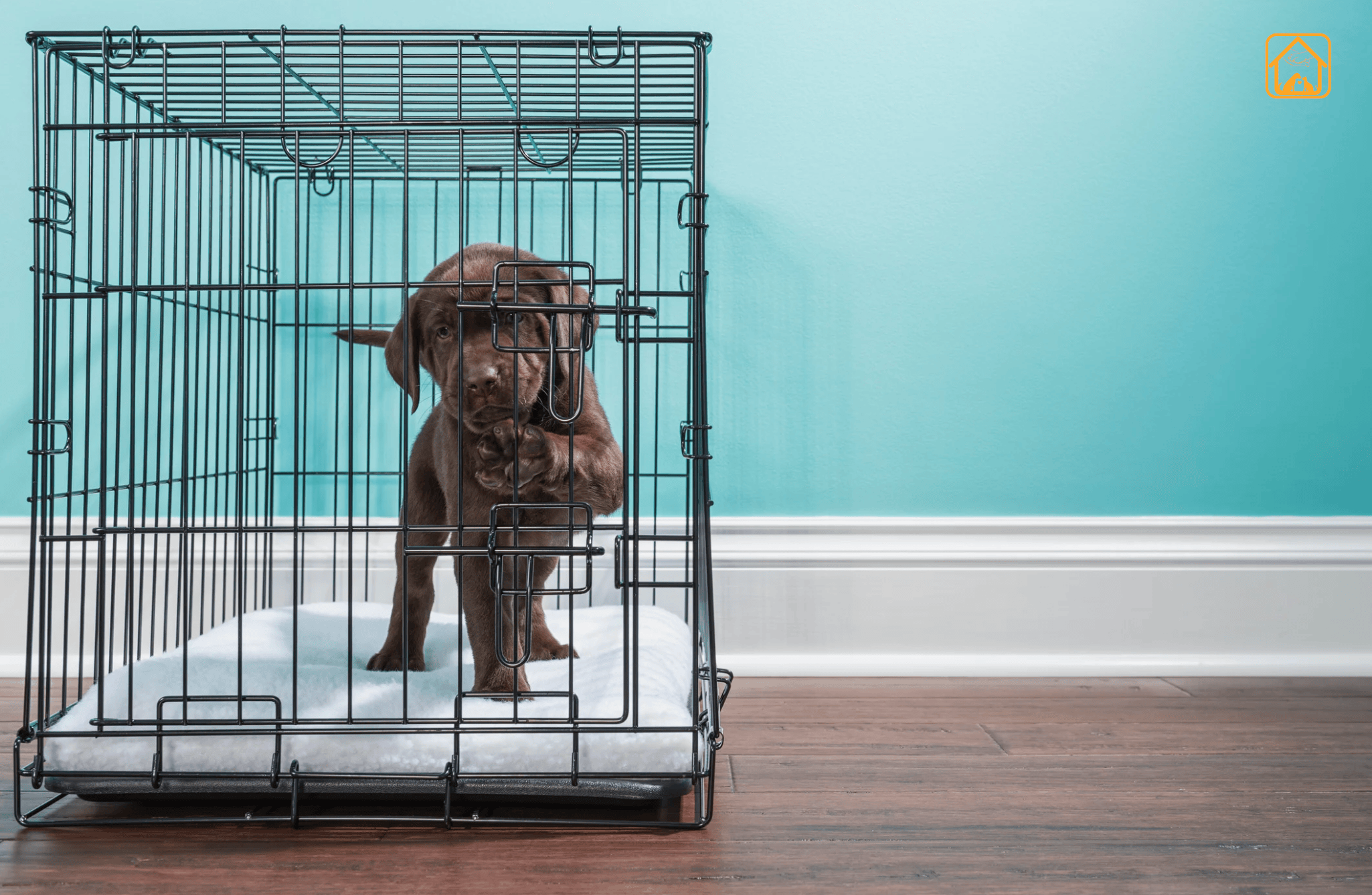
Crate training a puppy can feel daunting, but it’s one of the best tools for housebreaking and building confidence. Think of the crate as your puppy’s safe den, not a punishment. It’s a huge win for both your sanity and your pup’s confidence. Here’s how to get started:
Why Crate Training Works (And Isn’t Cruel!)
- Dogs are den animals. Puppies instinctively seek out small, secure spaces for rest and comfort.
- It speeds up house training. Most puppies won’t soil their sleeping space, so the crate helps them learn bladder control and builds bathroom routines.
- Prevents bad habits. No more midnight shoe-munching or kitchen raids while you sleep.
- Reduces separation anxiety. A crate-trained puppy can handle alone time without panic.
Step-by-Step: How to Crate Train Your Puppy
- Pick the right crate. It should be big enough for your puppy to stand, turn, and stretch out, but not so huge they can potty in one corner and nap in another. Wire crates, plastic kennels, and soft-sided options all work, as long as they’re safe and comfy.
- Make the crate inviting. Place it in a cozy, quiet spot near family activity (not isolated). Add a soft blanket, a favorite chew toy, and maybe a t-shirt with your scent. Leave the door open at first. For more on this, check out our guide on scent detection training.
- Encourage exploration. Toss a few tasty puppy training treats or kibble inside. Let your pup wander in and out at their own pace. Never force them in or slam the door shut, trust is everything!
- Start with short sessions. Once your puppy is comfortable, close the door for a few seconds while they nibble a treat. Gradually lengthen the time, 30 seconds, a minute, five minutes, etc. Always return before your puppy gets upset (they should associate the crate with calm, not panic).
- Feed meals in the crate. It’s a powerful positive association. Place the food bowl at the back and let your pup eat with the door open at first, then gradually close it during meals.
- Practice short absences. Step out of sight for a minute or two. Return calmly, rewarding your puppy for chilling out. Repeat, stretching the time as your pup relaxes.
- Crate at bedtime and when you leave. For the first few nights, keep the crate near your bed. If your puppy cries, wait a minute before responding, if you rush in every time, they’ll learn that noise gets results!
Crate Training Tips and Troubleshooting
- Never use the crate as punishment, it should always feel safe and positive.
- Take your puppy outside for a bathroom break immediately after crate time, especially first thing in the morning and after meals.
- If your puppy whines, check if they need to potty. If not, wait quietly until they settle before opening the door.
- Don’t crate your puppy for more hours than their age in months (e.g., a three-month-old shouldn’t be crated longer than three hours during the day).
Crate training can be tough at first, your puppy might whine or look sad. But I’ve seen lots of people change their minds once their pup starts happily sleeping in the crate, wagging their tail like it’s their favorite cozy spot.
Potty Training and Housebreaking Your Puppy
Potty training puppy is usually every pet parent’s biggest headache. The secret? Consistency and patience. Start house training a puppy as soon as you bring them home. Here’s a simple plan:
- Take your puppy out first thing in the morning, after meals, naps, and every 2 hours (or more for tiny pups).
- Pick a designated potty spot and always lead them there on a leash.
- Give lots of praise and a treat right after they go, don’t wait to get back inside.
- Supervise indoors, or use an indoor puppy potty area if needed.
- If you catch them in the act, interrupt gently and bring them outside. Never punish, accidents are part of the process.
Some puppies pick it up fast, others take weeks. If you stick to a potty training schedule by age (like every hour for an 8-week-old), you’ll see progress. Trust me, even the toughest cases turn the corner with structure and love.
Basic Commands and Obedience: Sit, Stay, Come, and More
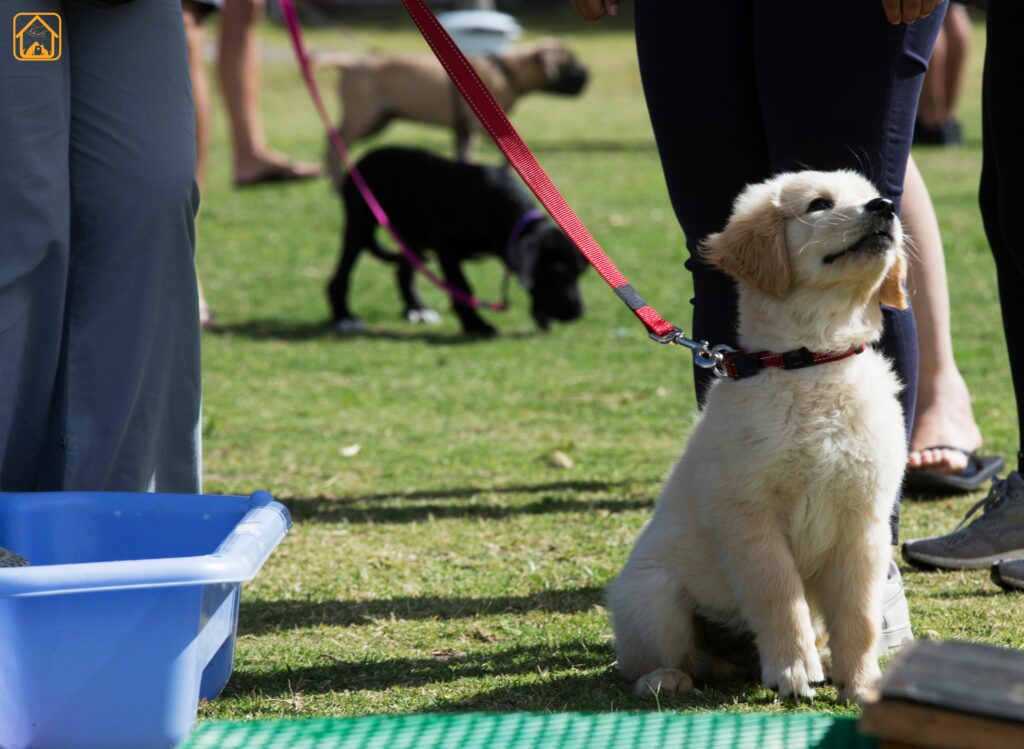
Basic obedience training isn’t just about showing off at the park (though, let’s be honest, it’s pretty satisfying when your pup sits politely while others go wild). It’s about safety, manners, and building trust.
When I first tried to teach my own puppy “sit,” she looked at me like I was speaking Martian. But after a few tries with a tasty treat, she started to get it. Consistency, patience, and timing matter way more than fancy techniques.
Your Puppy’s First Commands
Start with the essentials. Use short, clear words and reward every win. Here’s a quick rundown:
- Sit: Hold a treat near your pup’s nose, then move it up and back over their head. As their bottom touches the floor, reward and praise. Use the word “sit” every time. Check our guide on dog sit training.
- Pro tip: Practice before meals, when your puppy’s extra motivated.
- Stay: Once your puppy sits, open your palm toward them and say “stay.” Take a tiny step back. If they wait, reward right away, even if it’s only for a second at first. Build up duration slowly. Don’t get discouraged if your puppy pops up, just reset and try again. (Read: how to train dog to stay)
- Come: Use a happy, inviting voice. Crouch down, open your arms, and say “come!” Reward with a treat or a favorite toy when your puppy runs over. Practice in safe, distraction-free spaces, then add more excitement as your puppy improves. Want your dog to come running when called? Learn step-by-step in our guide on how to teach a dog to come.
- Down: Start with your puppy sitting, then move a treat slowly to the ground between their paws. As they follow it down, their body will lower wait until their elbows touch the floor. The moment they do, say “Yes!” and give the treat with lots of praise. Practice a few times daily, and soon your puppy will learn the “Down” command. Read how to teach dog lie down.
- Leave It: Place a treat in your closed fist. When your puppy stops sniffing or pawing, say “leave it,” then offer a different treat from your other hand. Read how to teach your dog for the command leave it.
How to Structure a Puppy Training Session
- Keep sessions short, 5-10 minutes for young puppies, several times a day.
- Practice in different rooms and later, safe outdoor spaces. Dogs don’t generalize well, so “sit” in the kitchen doesn’t always mean “sit” on the sidewalk!
- Always use positive reinforcement, treats, praise, or a favorite toy.
- End on a high note. If your puppy gets frustrated, finish with an easy win and a big “Yes!”
| Command | Why It Matters |
| Sit | Impulse control, polite greetings, prevents jumping |
| Stay | Keeps your puppy safe in busy places or at doors |
| Come | Recall is a lifesaver, literally |
| Down | Promotes calm, helps with vet visits and grooming |
| Leave It | Stops your puppy from eating or grabbing unsafe things |
Don’t rush. Some puppies master “sit” in a day, but “stay” might take weeks. If your puppy’s struggling, break it down into even tinier steps.
Preventing and Correcting Common Puppy Behavior Problems (Biting, Chewing, Barking)
Every puppy comes with a little mischief, teething, nipping, the midnight zoomies. The trick is to channel that wild energy into good habits before it becomes something you dread. Don’t worry, you’re not alone if your new puppy seems part land shark, part tornado. Here’s what works, straight from the trenches (and chewed-up slippers):
Puppy Biting and Nipping
- It’s normal. Puppies explore with their mouths and teeth for months. But you don’t have to be a chew toy.
- Redirect, don’t punish. When your puppy bites, say “Ouch!” (a little yelp gets their attention), then offer a safe chew toy or puppy training treat.
- Freeze play when biting happens. Stop all fun for a moment. Your puppy learns, “If I bite, playtime ends.”
- Encourage gentle play. Reward your puppy for licking or playing softly. Avoid rough wrestling, which can ramp up nipping.
Chewing Everything in Sight
- Manage the environment. Puppy-proof your home. Hide shoes, cords, and anything tempting. Use baby gates or a puppy pen when you can’t supervise.
- Offer lots of legal chews. Rotate safe, puppy-approved toys to keep things fresh and interesting.
- Catch them in the act. Calmly remove the forbidden item, offer a toy, and praise your puppy for chewing appropriately.
- Use boredom busters. Interactive toys, puzzle feeders, and regular play burn off that endless energy.
Barking: When It Starts to Drive You Wild
- Figure out the cause. Is your puppy bored, scared, excited, or seeking attention?
- Redirect and reward quiet. If your puppy barks for attention, ignore until they’re quiet, then praise and treat.
- Teach “quiet.” Say “quiet” as soon as barking stops, then reward.
- Meet their needs. Puppies bark less when they’re exercised, mentally stimulated, and not left alone for too long.
Puppies don’t know your rules until you teach them, over and over! If you’re struggling, reach out to a certified trainer for help. Sometimes, fresh eyes (and patience) make all the difference.
For practical tips on training your dog to stop barking, check out our simple and easy-to-follow barking guide.
Socialization, Puppy Classes, and Training Progression by Age
The most important lessons your puppy learns aren’t just about “sit” or “stay.” They’re about the world, new people, dogs, sounds, smells, and sights. Early, positive socialization shapes a confident, friendly adult dog. I’ve seen nervous puppies turn into a playful puppy, just from a few gentle games with new friends.
Why Socialization Matters
- Reduces fear and reactivity. Well-socialized puppies are less likely to develop anxiety, aggression, or phobias.
- Builds confidence. New experiences teach your puppy that the world is safe and interesting, not scary.
- Prevents future problems. A dog comfortable around people, kids, and other animals is a joy for life.
How to Socialize Your Puppy, Safely
- Start at home: Invite calm visitors, play soundtracks of city noises, introduce hats, umbrellas, or the vacuum.
- After vaccinations, explore parks, quiet streets, or pet-friendly stores.
- Let your puppy meet friendly, vaccinated dogs for supervised play.
- Handle your puppy’s paws, ears, and mouth, prepping for vet visits and grooming.
Don’t force interactions; let your puppy approach new things at their own pace. Use treats and praise for every brave step forward.
Puppy Classes and Training Progression
- Supervised play with other puppies, essential for learning bite inhibition and play skills.
- Practice with distractions, nothing builds a solid “sit” like a room full of wiggly pups!
- Support from experienced trainers who can spot and address problems early.
- Fun for both you and your puppy, training should be a joyful adventure, not a chore.
What to Teach, and When
| Age | Training Focus |
| 8-10 weeks | Name, gentle handling, crate training, potty training, basic cues (sit, come) |
| 10-16 weeks | Leash walking, more cues (down, leave it), puppy class socialization |
| 4-6 months | Longer walks, practicing with distractions, impulse control (wait at doors) |
| 6-12 months | Advanced cues, recall at distance, polite greetings, handling adolescence |
Be patient, every puppy learns at their own pace. The key is gentle, positive exposure and celebrating every tiny bit of progress. If your puppy has a setback go back a step, reward calmness, and rebuild confidence slowly.
Positive Reinforcement and Avoiding Common Puppy Training Mistakes
Positive reinforcement puppy training means rewarding good behavior with treats, praise, or play. Skip the punishment, it just confuses your puppy and can damage trust. Instead, focus on:
- Rewarding what you want to see, every time (especially early on).
- Keeping sessions short and upbeat, no marathon drills!
- Using the same words and signals for each command.
- Being patient when your puppy makes mistakes. They’re learning!
Common puppy training mistakes? Inconsistency, getting frustrated, or expecting too much too soon. I’ve made them all. The key is to reset, stay calm, and celebrate every tiny win. That’s how real progress happens.
Dog training becomes easier with the right tools, so what are you waiting for? Read our article on the best dog training tools to get the full list and start training smarter.
FAQs: Puppy Training Questions Answered
How old should my puppy be to start training?
Start as soon as your puppy comes home, usually at 8 weeks. Even young puppies can learn simple cues and routines through gentle, positive training. Early socialization and structure set your puppy up for lifelong success.
What’s the best puppy training method?
Positive reinforcement is the gold standard. Reward your puppy with treats, praise, or play when they get things right. Avoid punishment and harsh corrections, these can harm trust and slow learning.
How long does it take to potty train a puppy?
Most puppies take a few weeks to a few months to be fully housebroken. Stay consistent with routines and rewards, and remember that accidents are part of the learning process. If you’re struggling, a stricter potty training schedule can help.
Why is my puppy biting so much?
Puppies use their mouths to explore and play, especially when teething. Redirect biting to toys, teach bite inhibition, and avoid rough play. With time and patience, biting will decrease as your puppy matures.
When can I start socializing my puppy?
Start socializing your puppy right away by exposing them to safe people, sounds, and gentle handling. After vaccinations, gradually introduce your puppy to new dogs and places. Early socialization builds confidence and prevents fear-based behaviors.
Should I use a crate at night?
Yes, crate training at night helps your puppy feel secure and supports potty training. Make the crate comfortable, keep it near your bed at first, and use gentle encouragement, not punishment, for crate time. Most puppies adjust within a week or two.
What if my puppy doesn’t listen or makes mistakes?
All puppies make mistakes! Stay consistent, use the same cues, and reward good behavior. If something isn’t working, try shorter sessions or a higher-value treat. Progress may be slow some days, but every puppy gets there with positive guidance.
Are some puppies easier to train than others?
Absolutely, some breeds and individual puppies pick up cues faster. But every puppy can learn manners and commands with patience, positive reinforcement, and a structured puppy training schedule by age.
Can I train my puppy at home, or do I need classes?
You can do a lot of puppy training at home, especially with consistent routines and positive reinforcement. Puppy classes add structure, socialization, and expert tips, so they’re a great choice if you want extra support or your puppy needs more social exposure.
How can I stop my puppy from barking or whining?
Barking and whining are normal ways puppies communicate. Try to figure out the cause (boredom, fear, need to potty) and address it. Reward calm behavior, avoid yelling, and use crate time or redirection to manage excessive barking.
What should I do if I’m overwhelmed with puppy training?
It’s normal to feel overwhelmed, raising a puppy is a lot! Break things down, focus on one skill at a time, and don’t be afraid to ask for help. Online resources, local trainers, and support groups can make a big difference. Remember, every puppy parent has been there!
Conclusion
Training your puppy is one of the best ways to build trust and create a strong bond. With patience, consistency, and positive reinforcement, even the toughest days lead to progress. Stay calm, celebrate small wins, and keep it fun. Your efforts today will raise a confident, happy dog tomorrow.If you want more in-depth guidance, check out trusted sources like the AKC Puppy Training Timeline, or consult your local veterinarian for personalized advice. Your puppy will thank you later!
